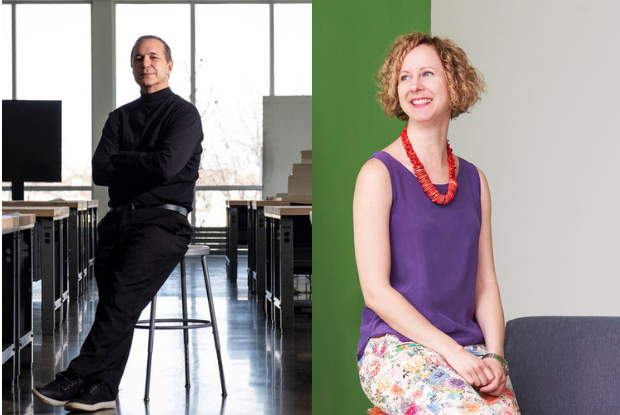Tyler Faculty Co-Teach Course on São Paulo’s Art and Architecture

In the Fall 2024 semester, Tyler faculty members Mariola Alvarez and Pablo Meninato are co-teaching a seminar that explores artistic and architectural developments that have taken place in the largest city in Latin America – São Paulo, Brazil – from the early 20th century through the present day.
For Alvarez, Assistant Professor of Modern and Contemporary Latin American Art and Director of Graduate Studies in Art History, and Meninato, Associate Professor in Architecture, the collaborative teaching model offers an opportunity to broaden the course’s scope to reflect the specializations of both faculty members and connect their respective research interests.
“Co-teaching allows cross-departmental conversations around research and making,” Alvarez shared. “It is also a chance to learn from fellow colleagues and model that kind of collaboration for students in their own careers.”
Alvarez is an art historian, and Meninato is an architectural historian. In her publications, Alvarez has focused primarily on the history of painting and sculpture in Brazil, while Meninato has written about urban design and architectural history across Latin America.
For Alvarez, working with Meninato uncovers new ways to study the impact of the built environment on artists. In her first book, The Affinity of Neoconcretism: Interdisciplinary Collaborations in Brazilian Modernism, 1954-1964 (University of California Press, 2023), Alvarez discusses the history of modern architecture and how it informed the development of modern art in Brazil.
“Teaching this topic with Professor Meninato enables me to revisit this historical moment with an expert in the field and thus dig deeper into the kinship of forms between constructed objects,” Alvarez said.
In turn, Meninato delves into the correspondence between contemporary art and architecture in his publications, including Unexpected Affinities: The History of Type in the Architectural Project from Laugier to Duchamp (Routledge, 2018) and Urban Labyrinths: Informal Settlements, Architecture, and Social Change in Latin America (Routledge, 2024), where he identifies parallels between the architectural and urban qualities of favelas (the Portuguese word for slum or shantytown) and the artistic explorations of Antonio Berni in Argentina and Hélio Oiticica in Brazil.
“The possibility of developing an intense collaboration with a historian specialized in Brazilian art will nurture and form my understanding of the correspondence between contemporary art and architectural developments in the Global South,” Meninato said.
São Paulo is among the world's most populous cities, with numerous cultural institutions and a rich architectural tradition. Home to more than 11 million inhabitants, with an extensive periphery that adds another nine million residents (about half the population of New York), São Paulo’s metropolitan area is the largest megalopolis in the Southern Hemisphere.
In the course, students explore not just the synthesis of art and architecture, but also envision how artists and architects have worked together to shape São Paulo. The seminar follows a roughly chronological trajectory, beginning with an overview of the history of modernism during the 20th century in São Paulo and key artistic, architectural, and urban developments. Each session of the class is dedicated to a specific feature or aspect of the city’s art and architecture.
“Additionally, we will address the intersections between political activism, art, and design, including questions such as urban interventions in favelas, the cultural impact of migrations, and the recent exhibitions at MASP, the São Paulo Museum of Art, focusing on themes such as sexuality, Afro-Atlantis, and gender,” Meninato said.
Students also analyze the prevailing trends and pivotal figures that have shaped the city’s artistic, urban, and architectural landscape in recent history. The last portion of the course will focus on contemporary artistic and design expressions such as film, theater, dance, music, and street art.
“A notable aspect—that will be likely a matter of discussion with the class—is how, throughout the 20th century, artistic and urban initiatives were impacted and influenced by social and political developments,” Alvarez said. “This helps explain the large number of artists and architects who have been, and continue to be, at the forefront of social and political engagement.”
Alvarez researches and writes about modern and contemporary Brazilian art with a focus on artistic production in the early and mid-20th century, including Japanese immigrant artists and abstract artists. Her current book project, supported by a Fulbright award, examines the early generations of Japanese immigrants to São Paulo and how they formed community and negotiated the city’s artistic scene.
Meninato’s recent publication, Urban Labyrinths. Informal Settlements, Architecture, and Social Change in Latin America, discusses the design intervention in informal settlements in various Latin American cities, including a chapter dedicated to São Paulo. In addition, he is the recipient of a 2024-2025 Fulbright U.S. Scholar award for a research and publication project on Italo-Brazilian architect Lina Bo Bardi, whose projects and buildings are predominantly located in São Paulo and Bahia.
In conjunction with the course, Meninato and Alvarez will welcome Dr. Fernando Luiz Lara to Tyler for an event on Wednesday, October 16 at 2:30 p.m. Lara, a Professor at the Weitzman School of Design at the University of Pennsylvania, will be in conversation with students about the city of São Paulo. He works on theorizing spaces of the Americas, with an emphasis on the dissemination of design ideas beyond the traditional disciplinary boundaries.